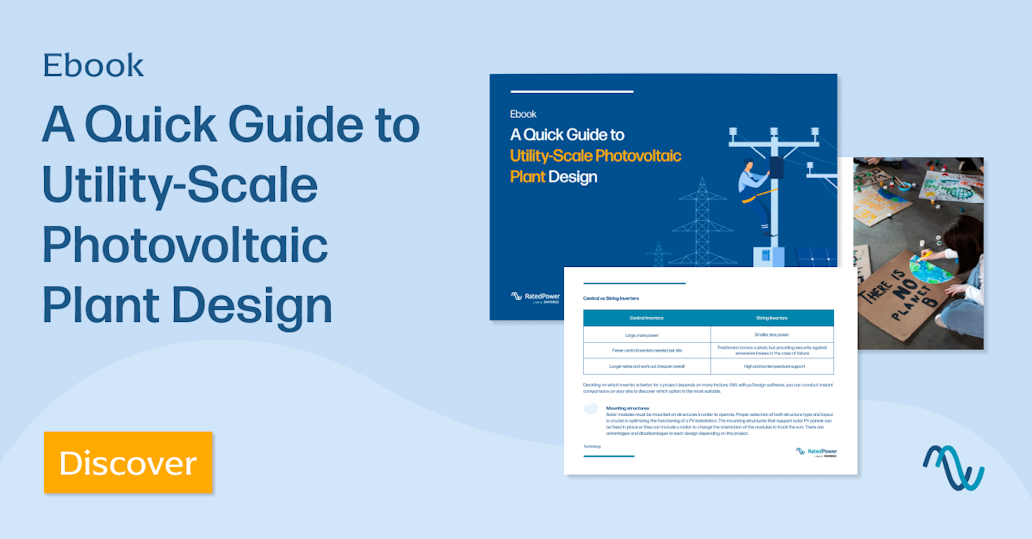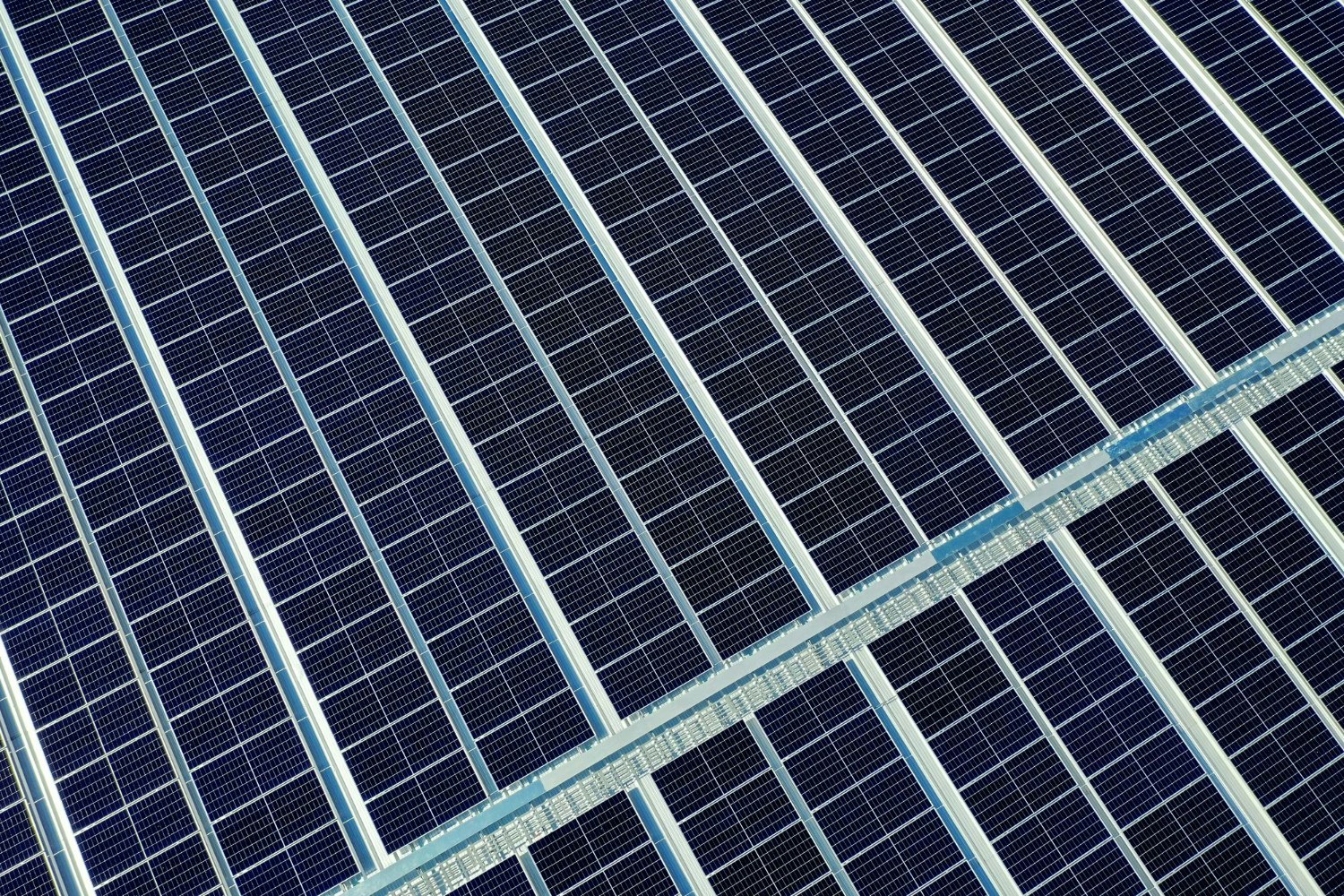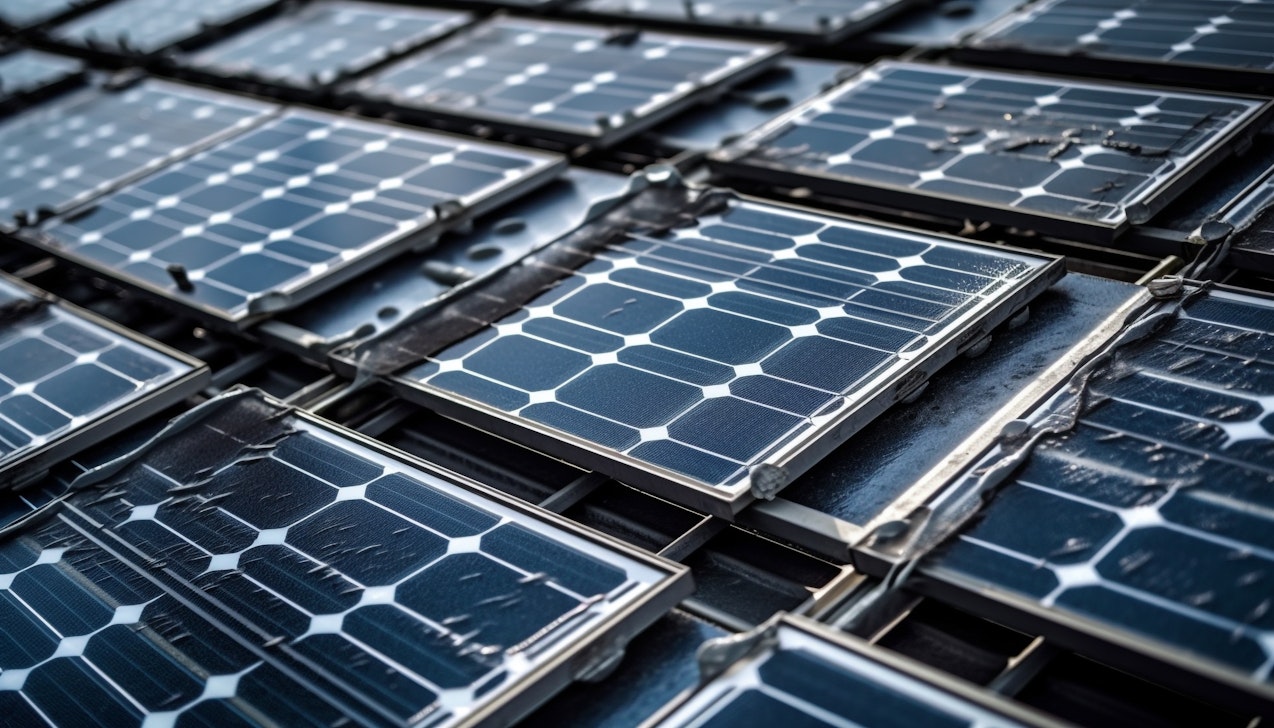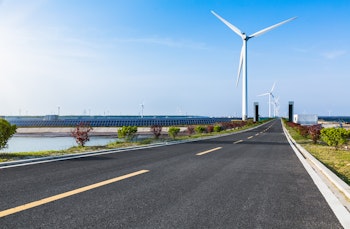Everything you need to know about photovoltaic systems
- Published by
- Reviewed byHassan Farhat
![]()
Hassan Farhat
Hassan Farhat has a background in Energy Engineering and excelled in his Master of Science in Renewable Energy in Electrical Systems. More than three years ago, he joined the RatedPower technical team, where he works as a Solar Photovoltaic Engineer and Customer Success Manager at RatedPower.
Hassan has a thorough understanding of the industry and of RatedPower’s pvDesign, the digital solution to reduce LCOE and maximize productivity of utility-scale PV plants. He's passionate for renewable energies and their role within the global environmental transition.
14 Mar, 24

A quick guide to utility-scale photovoltaic plant design
This guide will give an overview of the key considerations for designing your next utility-scale solar PV plant.

Learn about the history and application of photovoltaic systems in this back-to-basics article.
Here at RatedPower, solar photovoltaic system design is our bread and butter. However, we know this technology can be difficult to understand as it’s constantly evolving and driven by complex mechanisms.
That’s why we’ve created this back-to-basics article on solar photovoltaic systems. Read on for more!
What does photovoltaic mean?
Photovoltaic, derived from the Greek words for light and energy, phos and volt, refers to the conversion of light directly into electricity. Literally translated, it means “light energy.”
This conversion is achieved through the use of semiconductor materials, such as silicon and cadmium telluride.
The history of photovoltaics
Solar technology has a long history, longer than you might think. In fact, the first recorded mention of solar technology was back in 1767 when Swiss scientist Horace-Benedict de Saussure designed what he called a “solar collector cell.”
These solar collector cells were essentially glorified magnifying glasses, with multiple layers of glass focusing the sun into an insulated box to capture the heat generated. After this, the next and perhaps most significant leap came in 1839.
Young French scientist Edmond Becquerel first observed the photovoltaic effect when experimenting with conductance and illumination. The photovoltaic effect is the process by which sunlight is converted into electricity, although it would be a number of years from this first observation until the process was understood and described for the first time.
A number of scientists made contributions to the field during the rest of the 1800s, with the photovoltaic effect being observed in selenium which later led to the construction of the first selenium solar cell in 1877. At this time, scientists knew that the photovoltaic effect worked but no one knew how.
The theory behind the photovoltaic effect was first described by a familiar name, Albert Einstein. In his 1905 paper, Einstein described what he termed the “photoelectric effect,” laying out the photovoltaic effect in detail for the first time. This discovery would go on to net him the Nobel Prize in physics in 1922.
The first practical solar cell was developed in 1954 by scientists at the Bell Laboratory. With this first boundary crossed, the US government began pouring substantial funding into solar PV research with the hopes of creating viable solar panels to be used on orbiting satellites.
With the increased time and resources being dedicated to research and development, solar PV technology came on leaps and bounds in the following decades, including becoming the universal source of power for space operations.
In 1990, researchers in Australia reported a crystalline silicon solar cell with an efficiency of 25%. This represented over 80% of the theoretical maximum of such cells that had previously been established. This breakthrough was swiftly followed in 1999 by the total installed capacity of solar cells exceeding 1000 MW.
With this milestone, solar PV had finally become a viable, utility-scale power solution. In the past 20 years, solar technology has continued to improve, with new types of solar cells being developed and solar panels being made available for commercial use, leading to a boom in residential solar arrays.
Now that we’ve looked at the history of photovoltaics, let’s look in more detail at exactly how they work.
What is a photovoltaic cell?

A photovoltaic (PV) cell is the physical piece of equipment that converts light into electricity. PV cells usually consist of a number of different layers, each serving a specific purpose. These layers will differ depending on the type of cell but typically include:
- Semiconductor layer — This is the layer that actually converts the light into electrical energy. Made up of two distinct layers: p-type & n-type
- Conducting layers — Sit on either side of the semiconductor layer, the conducting material collects the energy produced
- Anti-reflection coating — This layer is applied to the side of the cell that is facing the sun and is used to reduce the amount of light that is reflected off of the PV cell
- Frames and Glass — The PV cell is encased in a frame, usually made of aluminum, and is covered by a protective layer of glass to avoid damage to the cell
How does a photovoltaic cell work?
PV cells convert light into electrical energy through a process called the photovoltaic effect. As previously mentioned, his was first observed in 1839 by Edmond Becquerel and works in the following way:
Two layers of semiconductor, p-type and n-type, are put together to form a p-n junction
Electrons move between the two layers to form an electrical field, which causes positively charged particles to move in one direction and negatively charged particles to move in the other
When photons, energy particles in light, hit the semiconductor layer, the energy they are carrying is transferred to the electrons in the p-n junction
These electrons move to a higher energy level and move through the semiconductor material
Due to the electrical field in the p-n junction, the electrons move in one direction creating an electrical current
This electrical energy can then be transferred or stored
How are solar panels and photovoltaic cells made?
There are a number of different types of PV cells, including silicon-based, thin-film, and perovskite.
Silicon-based cells are far and away the most popular type of PV cells. They are made by forming a crystalline silicon lattice that is very efficient at converting light into electricity. With silicon being very abundant and the crystalline lattice fairly easy to manufacture, silicon-based cells offer high power output, low-cost cells with a long life expectancy.
Thin-film PV cells are made by laying one or several layers of conducting material, usually cadmium telluride or copper indium gallium diselenide, directly on either the front or back of the module’s surface.
Perovskite cells are a relatively new development in the PV space, but one that has advanced more rapidly than any other. They are made by layering conducting materials onto a supportive layer known as a substrate. They provide high energy efficiency, similar silicon-based cells, and research is being done into increasing their longevity.
Solar panels, or modules, are then manufactured by taking individual solar cells and clustering them together into one structure.

The cost of photovoltaic materials
As covered in the previous section, there are a number of different materials that solar photovoltaic modules can be made from. These are specific materials that can be used to most effectively generate the photovoltaic effect and in turn produce electricity. Due to the limited number of suitable materials for PV module construction, the prices of said materials are intrinsically linked to the cost of module manufacturing.
Given its place as the most popular, and arguably most important, material in PV module development, polysilicon prices are most closely tied to the overall price of photovoltaic modules. There has been a great deal of movement in the price of polysilicon in recent years, with the material currently experiencing a low, leading to lower prices for PV modules.
In China, however, the world’s largest solar module manufacturer has seen an increase in polysilicon prices in recent months. The fluctuations in prices are driven by a variety of factors, such as bounce back after the pandemic and tariffs on imports and exports. In practice, these fluctuations can lead to instability in the market and can stunt progress when it is needed most.
Of course, polysilicon is not the only material used in the manufacture of solar modules. Aluminum, for example, is used in almost every solar panel made, regardless of the type of the panel, again tying the price of the metal inextricably to the cost of manufacture.
Other materials, such as perovskite, cadmium, and copper are also used in the manufacture of different types of PV panels and their costs must be taken into account, especially given their relative scarcity compared to silicon and aluminum.
What is a photovoltaic system?
A photovoltaic system refers to the entire system created to produce electricity and delivers it to either the grid or to end users. There are two main types of PV systems:
Grid-connected (on-grid) — These PV systems are directly connected to the electrical grid and deliver electricity straight to the main supply
Stand-alone (off-grid) — These PV systems contain battery energy storage solutions (BESS) that collect the electricity generated and store it. This electricity can then be used as and when it is needed.
Hybrid — These are PV systems that combine with other energy sources such as wind or hydro turbines, fuel cells or diesel generators
In order to generate and supply electricity, there are a number of components that work in tandem that have a direct effect on its output:
Photovoltaic modules — As discussed above, these modules are where sunlight is converted into electricity through the photovoltaic effect
Module structures — These are the physical supports that hold the modules in place. Strategic and intelligent design is required to optimize the efficiency of solar modules
Inverters — PV modules produce direct current (DC) electricity. The role of the solar inverter is to convert this DC electricity into alternating current (AC) electricity that is used by the utility grid
Transmission cables — This is how the electricity is delivered from the modules to where it needs to go
Storage systems — Some PV systems will contain BESS to store the electricity that is generated for use when and where it is required
Solar PV system efficiency
One of the key considerations for most PV systems is maximizing efficiency. There are a couple of factors at play here. First is the efficiency of the modules themselves, or, what percentage of the solar energy that hits a solar panel is converted into electricity.
Solar panel efficiency varies depending on the type of solar panel used but typically, you can expect somewhere between 17 - 20% efficiency for most solar panels. There have been PV panels developed that achieve far higher efficiencies than this, but these are currently not commercially viable.
The other thing to consider is the overall efficiency of a solar installation. This will be affected by things like near and far shading, the types of trackers used, and the climate of the chosen site. Ultimately, how a solar installation is designed will determine how efficient it is, making the design stage one of the most crucial stages in solar development.
Applications of photovoltaic systems
The primary and most important application of a photovoltaic system is the generation of clean, renewable electricity. Since photovoltaic cells convert sunlight into electricity, this energy source is inherently renewable, as long as the sun continues to shine, the electricity will continue to flow.
PV systems also do not produce any harmful emissions, such as carbon dioxide. This lack of emissions makes solar energy clean and therefore not harmful to the environment nor a contributor to climate change.
PV systems also have the potential to offer solar power to localized, underserved communities. With the rapid development of commercial PV technology, consumers can install small PV systems on their homes or businesses, supplying themselves with clean solar energy and potentially earning extra income by selling excess energy back to the grid.
Finally, PV systems, especially those with built-in BESS, have the potential to alleviate grid instability by providing a renewable source of solar energy if the main grid goes down.
The largest PV plants and PV systems worldwide
Dive into some of the largest PV plants in the world and some upcoming projects that will add further to global solar capacity by downloading out eBook: The Largest PV Plants Worldwide.
Bhadla Solar Park, India
With recent improvements, the Bhadla Solar Park in India’s Thar Desert now has an impressive installed capacity of 2.7 GW. Spread over 14,000 acres, the park is owned and operated by a number of different businesses that each hold a share of the capacity.
Huanghe Hydropower Golmud City Solar Park, China
Located in Qinghai, China, Golmud City Solar Park is the largest solar park in the world with a whopping 2.2 GW of installed capacity. This installation generates enough solar electricity to power over one million homes and houses 7.2 million solar PV panels.
Pavagada Solar Park, India
For more insights, news, and information on everything PV, head over to the RatedPower resources page!

Design utility-scale solar at lightning speed
Related glossary posts
Searching results
Related posts
Searching results



